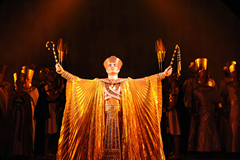| A successful if not triumphant Aida by Sarah Noble | |
| Verdi: Aida Opera Australia Sydney Opera House 7 July 2009 | |
| Verdi's Aida is an opera which leads a double life. At one (lucrative) level, it's a crowd pleaser par excellence, a favourite choice for arena spectaculars and a boon to directors who relish the chance to put an elephant or two on stage. Beyond the spectacle, however, Aida is also a perceptive examination of personal relationships ruptured by politics: the kind of opera of which Verdi, especially in his late career, was a master. Opera Australia's new production of Aida highlights this dual nature. Graeme Murphy's staging (realised in sets and costumes by Roger Kirk) presents three dimensional lives against a two dimensional background, an Egypt represented by massive cut-outs and an all-pervasive black/white/gold colour scheme. This bold aesthetic is appealing, but in the first two acts especially, Murphy's deliberate artificiality sometimes bears too close a resemblance to the clumsy décor of an amateur production, thus diffusing the impact of its stylisation. A change comes in the second half, however, as constant movement and fanciful flats give way to a far more focused vision. From cluttered beginnings, a seriously striking Aida now takes shape, culminating in a final act whose visual impact at last matches the deep, dark intensity of its musical and dramatic climax. Musically, the performance follows a similar trajectory. Sir Richard Armstrong's leadership of the Australian Opera and Ballet Orchestra is robust throughout but troubled initially by balance and tempo issues. As Murphy's staging begins to glow, however, so too does the orchestral sound, which is eventually as awash with gold as the stage. The chorus is switched on from the beginning, a vibrant vocal and visual presence. | |
|
Bass David Parkin, who won the ABC TV show Operatunity Oz in 2006, makes his official company début as an imposing King of Egypt, overcoming initial nerves to prove himself once again a basso profundo of serious promise. Jud Arthur brings his characteristic vocal authority to Ramfis, despite occasional throat trouble on opening night. Amy Wilkinson sings well from offstage as the Priestess, although there's not much of the celestial about her voice. Also noteworthy are the virtuosic performances by the company of dancers engaged for this production. Murphy is, after all, first and foremost a choreographer, and dance not surprisingly plays a prominent part in his staging, to mostly successful and occasionally revelatory effect. Aida is a double edged sword, so it's fitting that this production offers such a collection of dualities, intentional and otherwise. Had it remained at the level of its first two acts, this would be a troubled Aida at best, musical accomplishments notwithstanding. But the marked improvement in the final acts of every aspect of the performance is enough to make it a success, albeit a qualified one. If the first half can be raised to the dynamic level of the second, it might even become a triumph. | |
| Text © Sarah Noble Photos © Branco Gaica |
 Among the four principal singers, only two start as they mean to continue. From her first note to her last, Tamara Wilson's Aida displays a voice of distinctive beauty and apparently effortless power, warm and evenly produced throughout her considerable range. While not a natural actress, she is a sincere and sympathetic heroine. As her father, Amonasro, Michael Lewis is likewise excellent from his first appearance, his commanding voice and presence carrying all the hallmarks of a first rate Verdi baritone. Dongwon Shin copes well with Radames' demanding "Celeste Aida," but not until his third act assignation with Aida does the thrilling power of his voice properly reveal itself. His muscular tenor blends effectively with Wilson's tender soprano in their shimmering final duet. Milijana Nikolic, as a feline Amneris, also takes time to warm up, but her earthy contralto flares up in the final act with a blistering depiction of the princess's inner torment.
Among the four principal singers, only two start as they mean to continue. From her first note to her last, Tamara Wilson's Aida displays a voice of distinctive beauty and apparently effortless power, warm and evenly produced throughout her considerable range. While not a natural actress, she is a sincere and sympathetic heroine. As her father, Amonasro, Michael Lewis is likewise excellent from his first appearance, his commanding voice and presence carrying all the hallmarks of a first rate Verdi baritone. Dongwon Shin copes well with Radames' demanding "Celeste Aida," but not until his third act assignation with Aida does the thrilling power of his voice properly reveal itself. His muscular tenor blends effectively with Wilson's tender soprano in their shimmering final duet. Milijana Nikolic, as a feline Amneris, also takes time to warm up, but her earthy contralto flares up in the final act with a blistering depiction of the princess's inner torment.